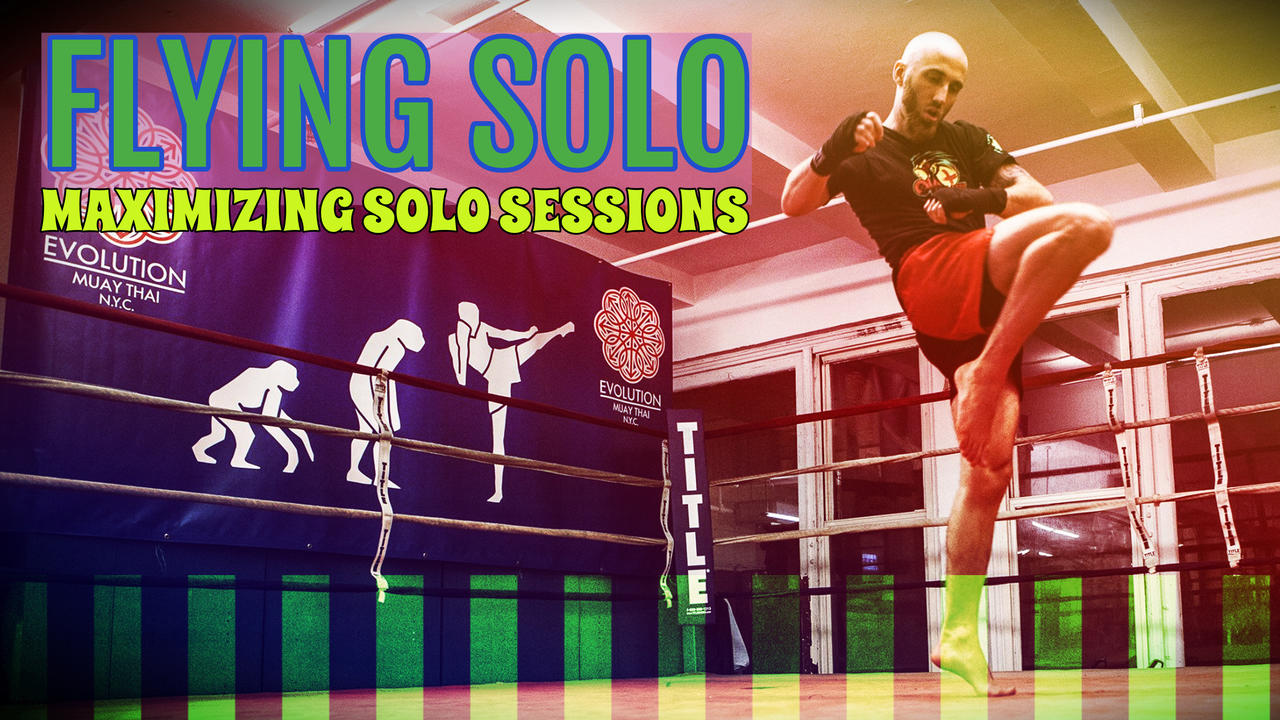Coachless: Solo Sessions & You

MAKING THE BEST OUT OF OPEN MAT & SOLO SESSIONS
By Emily Moore
Have you ever shown up at the gym only to find out that you’re the only one there?
Maybe your coach had an emergency and needed to step away, or your training partner bailed on you. You still want to get a good workout in but do you know how to structure your own training when no one is there to guide you?
If you’ve always had a coach there to tell you what to do and how to flow from one drill or exercise to the next, approaching an open mat or solo training session can be a little confusing. You can enter the training session with good intentions and strong motivation, but without some forethought and planning you might end up halfheartedly hitting the heavy bag for two and a half rounds before deciding to go home.
Training on your own is great; fighting, after all, is something that you ultimately have to do alone. Just like you can’t go into a fight without preparation, you can’t go train on your own without some preparation as well.
These tips will help you plan your next solo workout and get the most out of those open mat sessions.
Know Who & What You Need
In a previous article, I talked briefly about planning out your weeks of training in advance. When you’re planning out your training schedule, it helps to know who and what you will need for each training day.
For example, on Monday, you might plan to attend a Muay Thai class led by the trainers or your coach, Tuesday you might plan to meet with your teammates for skills, drills and conditioning, and you might set aside Wednesday to train solo. You’ll be more prepared for an open mat training session if you actually planned on doing one.
For some training sessions, you will need your coach there to guide and monitor you. This is true for:
- sparring sessions
- learning new techniques
- putting the finishing touches on your fight camp work
For others, you may just need your teammates. This is the case for:
- drills
- pad work/mitt work
- perfecting techniques you already know
For other days, you may just need yourself and the gym. Some days, you may not even need the gym — you can shadowbox, skip rope, run sprints, and do body weight strength work almost anywhere.
Know Your Goals
How many times have you shown up to an open mat training session, knocked the heavy bag around a few times, and then got bored and went home? This is sure to happen if you don’t go into the session knowing what you want to accomplish.
Think about the way that your coaches structure your classes. They usually have a theme that they follow throughout class, such as different ways to respond to the body kick, various methods of entering clinch, or using punches to set up kicks. They will spend the entire class drilling the same idea because repetition is key to making the technique a part of your Muay Thai arsenal.
Follow this structure in your solo training: pick one thing that you want to spend the open mat session improving.
This doesn’t mean that you can only throw one strike or drill one technique but rather that everything you practice during the solo session needs to relate to the priority that you’ve chosen. That priority could be anything from “improve my jab” to “work combos ending in a low kick” to “work on angles.
Write It Down
Now that you’ve chosen a priority for your training session, physically write down the workout you will use to for that priority. You can write it down on a slip of paper and stick it in your gym bag, but I actually recommend keeping a training notebook. That way you can look back and see what you’ve done in the past and improve upon it later.
Below is an example of a solo workout that I have from my own training notebook. As you can see, I chose to focus that particular training session on drilling the low kick:
I started out the workout by doing two 2-minute rounds of skipping rope to warm up. Then I did some gentle dynamic stretching to get loose and then shadowboxed, drilling the low kick at the end of every combo, for a 3-minute round.
The main part of the workout began with a 3-minute round practicing the technique of the low kick on the heavy bag — making sure I was turning my hip over, pivoting up on the ball of my base foot, striking with the length of my shin, and falling back into my fighting stance afterwards.
The second round was about power, using the technique I’d just practiced in the round before to generate force.
In the third round, I maintained the power in the low kick but used punch combos to set up the low kick strike. The fourth round was similar, only I used kicks and knees before ending in a strong low kick. The fifth round was freestyle, using any combo of punches, kicks, elbows, or knees before ending in the low kick. Then, after a longer rest period and some water, I repeated the entire five rounds from start to finish once more.
After the heavy bag rounds, I did some conditioning drills that targeted my core and my hips — muscle groups that are instrumental in performing a strong low kick. After my conditioning drills and more water, I stretched carefully, making sure that I focused on opening my hips.
You can plan a similar workout, tailored to focus on a technique or concept that you want to work on during your solo sessions. Write down exactly what you want to do from start to finish, and you won’t get bored or run out of things to work on during open mat. By the end of the focused training session that I detailed above, my low kick had improved immensely.
Solo Sessions Are Optimal For Conditioning
You don’t need a partner or a coach to stretch, do strength training, to run, or do speed drills.
If you show up to the gym and no one’s there and you don’t have a session planned for the day, try doing things that will improve your strength and physical fitness.
Try out Tabata Interval Training. Tabata is a variant of HIIT (High Intensity Interval Training) which is meant to improve both your aerobic and anaerobic fitness levels.
Also known as the “32 Round Workout,” this style of interval training features eight rounds of 20 seconds on, 10 seconds off, for each exercise. As an example of this:
- Pull-ups – 20 seconds work, 10 seconds rest — x8
- Push-ups – 20 seconds work, 10 seconds rest — x8
- Air squats – 20 seconds work, 10 seconds rest — x8
- Sit-ups – 20 seconds work, 10 seconds rest — x8
Straight through, no rest between exercises. The only rest period you get is the 10 seconds between each 20 second round. After you’ve done pull-ups for 20 seconds, eight times through, move immediately to push-ups.
This is a highly advanced workout regimen, so this is decidedly not easy. If your body and conditioning are up to the task, see if you can complete the entire Tabata interval at least twice through, with just a five-minute rest in between the two interval sets. This should equate to about a 40-minute workout in total, as each eight-round interval exercise takes about four minutes to complete. This is just one example of the many conditioning workouts you can do on your own.
Remember: solo workouts and open mat sessions aren’t about just showing up and hitting the bag. Have a goal, detail out how you’ll achieve that goal, and be constructive. Happy training, fellow nak muays.
Feed Your Muay Thai Addiction!
Join our "Muay Thai Mondays" email newsletter for the latest updates on new videos, special events and everything Muay Thai!









